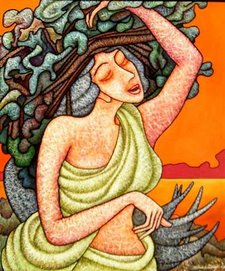I remember the first time I drove through the area, I was fascinated by the buildings and the tombs and the contrast between some densely populated, bustling and other desolate, quiet, desserted sections in that area. When I mentioned this to a friend, she told me about the City of the Dead. Its not an area that many Cairenes like to visit, given that its a necropolis, she explained. As a name, it is, I must admit, a little macabre.
However, some of the tombs are really beautiful, and each time, I go to the Khan and come back I am very tempted to stop, but never could, due to paucity of time. But a few days ago, I decided that this was D day and come what ever may, the City of the Dead it was going to be!
I had been looking up some stuff on City of Dead before, and, I realised that big mausoleums like these were intended as complexes which included residential areas, kitchens, baths, bakeries, grain mills, a market place, rooms for travelers and small streets.
Also in cemeteries during those times also included small palaces and other residences for the wealtly to visit their dead in comfort. So most of the mausoleums belonging to the rich noblemen were large complexes, and, not just small tombs.
Other than just roaming around the necropolis, and exploring the various tombs and mosques, there were a few places on my list that I definately wanted to see:
a/ Mosque of Sultan Qait Bay
b/ Khankah of Sultan Farag Ibn Barquq
c/ Khankah of Sultan Al-Ashraf Barsbay
d/ Mausoleum of Ahmed Hassanein Pasha
e/ Tomb of Emir Sulayman
Unfortunately, I only managed to see two - that of Sultan Qait Bay and Sultan. Will have to go back for the other three another day!
Mosque of Sultan Qait Bay
Perhaps, one of the most beautiful mosque/ tomb in the City of the Dead is the mosque of Sultan Qait Bay. In fact I remember it being described as the "jewel in the crown" for the mausoleums in the Cities of the Dead.
Purchased for a princely sum of fifty dinar, Sultan Qait Bay was a Mamluk slave who worked his way up through the ranks to become commander-in-chief of the army, and ultimately sultan.
He fought sixteen military campaigns, but is best remembered for the spectacular buildings he left. His buildings graced Mecca, Medina, Jerusalem, Damascus, and every quarter of Cairo. Out of more than 60 constructions and renovations he sponsored in Egypt, Syria, Palestine and Mecca, his most famous is the Qait Bay Citadel in Alexandria
When you walk inside the mosque, you understand why someone had referred it to as the "jewel in the crown". It is indeed beautiful albiet small.
I had asked one of the caretakers to take a photograph of mine, and, after that I was surprised to find a policeman / guard following me around, muttering in Arabic and wildly gesturing towards my camera. For a moment I thought that perhaps it was not permitted to take photographs, so rather hesitatingly I asked "mish mumkin (not possible)?" He gestured no and once again at the camera. Then when I was reviewing the photos, it struck me! The man had happily sneaked in behind me while the snap had been clicked and wanted to see his photograph! There you can see him, pose et all!
The ceiling is decorated beautifully with the traditional Islamic design tools - calligraphy, geometric patterns and arabesque designs. You can see the shape of the star worked in the ceiling pattern (below). The star, I understand is quite prominently used in Islamic art as a symbol of guidance often mentioned in the Quran.
The mosque has beautiful stained glass windows on two sides, much in the fashion of the long windows in old English castles.
During the afternoons, when the sun rays filter in through these windows, they cast the coloured shadow of these windows on the floor and the walls giving the impression of the stone smoldering in the aftermath of a raging fire!
Of course, you see this mosque every single day, but might find it difficult to recognise it. Where have you seen it? Well, on the LE 1 note that you handle every single day!
The reality is far more beautiful and the picture on the LE 1 note does not do the mosque justice. Go see it!







No comments:
Post a Comment